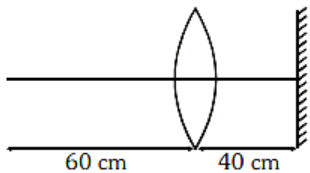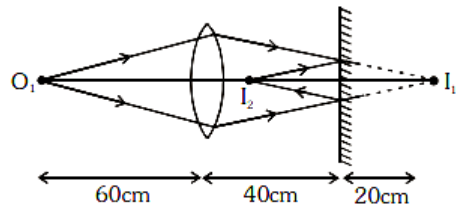A point object is placed at a distance of 60 cm from a convex lens of a focal length of 30 cm. If a plane mirror were put perpendicular to the principal axis of the lens and at a distance of 40cm from it, the final image would be formed at a distance of –
By BYJU'S Exam Prep
Updated on: September 13th, 2023

- 20 cm from the plane mirror, it would be a virtual image
- 20 cm from the lens, it would be a real image
- 30 cm from the lens, it would be a real image
- 30 cm from the plane mirror, it would be a virtual image
Let us use the lens formula
1/v1 – 1/u = 1/f
Given
u = -60 cm
f = 30 cm
v1 = ?
For the first refraction from a convex lens
1/v1 + 1/60 = 1/30
So we get
v1 = 60 cm

l1 is the first image by the lens
An image will be produced by the plane image at a 20 cm distance to the left of it
For the second refraction from a convex lens
u = -20 cm
v = ?
f = 30 cm
Using the lens formula
1/v – 1/(-20) = 1/30
v = -60 cm
The final image is virtual and at a distance of 60 – 40 = 20 cm from the plane mirror.
Therefore, the final image would be formed at a distance of 20 cm from the plane mirror; it would be a virtual image.
Summary:
A point object is placed at a distance of 60 cm from a convex lens of a focal length of 30 cm. If a plane mirror were put perpendicular to the principal axis of the lens and at a distance of 40cm from it, the final image would be formed at a distance of –
A point object is placed at a distance of 60 cm from a convex lens of a focal length of 30 cm. If a plane mirror were put perpendicular to the principal axis of the lens and at a distance of 40cm from it, the final image would be formed at a distance of 20 cm from the plane mirror; it would be a virtual image.
Related Questions:-


